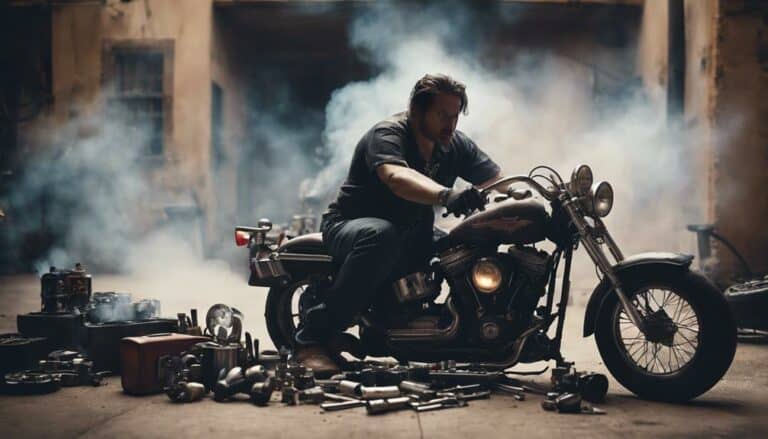If your carbureted Harley Davidson is sputtering or chugging, you may have heard that adjusting the carburetor could be the solution.
But what if the issue persists even after carburetor adjustments? Is there a deeper underlying cause that might be overlooked?
Stay tuned as we explore the intricacies of why your Harley might be sputtering, delving into potential reasons beyond the carburetor adjustments that could be causing this frustrating issue.
Key Takeaways
- Check for clogged jets or fuel passages in the carburetor.
- Inspect the ignition system for issues causing sputtering.
- Address air-fuel mixture problems and vacuum leaks promptly.
- Regularly maintain carburetor, fuel system, and ignition components.
Common Causes of Sputtering in Carbureted Harleys
Experiencing sputtering issues in your carbureted Harley Davidson? When dealing with such problems, it's important to take into account several key factors.
Clogged jets or fuel passages within the carburetor can disrupt the proper fuel flow, leading to sputtering. Vacuum leaks in the intake system, including the manifold or hoses, can create an abnormal air-fuel mixture, resulting in erratic engine behavior. Incorrect carburetor adjustments, such as the fuel/air mixture screw, can also contribute to sputtering complications. Additionally, worn-out or deteriorated gaskets in the carburetor can introduce air or fuel leaks, further exacerbating the issue.
In addition, old or degraded fuel circulating within the system can hinder proper combustion, causing the engine to sputter. Ensuring that the fuel is clean and fresh is essential for the best performance.
Diagnosing Sputtering Issues on Carbureted Harleys
When diagnosing sputtering issues on carbureted Harleys, key components to inspect include the fuel system, ignition system, air intake, and timing for potential causes.
Sputtering problems can often be traced back to issues such as faulty spark plugs in the ignition system. Spark plugs play an essential role in igniting the air-fuel mixture in the combustion chamber. If the spark plugs are worn out or not firing correctly, it can lead to misfires and sputtering. Regular maintenance, including checking and replacing spark plugs when needed, is vital to keep your carbureted Harley running smoothly.
Additionally, problems with the air intake system can also cause sputtering. Vacuum leaks, which can occur in the intake manifold or hoses, disrupt the proper air-fuel ratio needed for combustion. Ensuring that the air intake system is free of leaks and blockages is critical in preventing sputtering issues.
Addressing Fuel-Related Sputtering in Harleys
To effectively address fuel-related sputtering in Harley Davidson motorcycles, diagnosing and resolving issues with the air-fuel mixture is essential. Sputtering problems can arise from various fuel system components such as dirty fuel injectors, clogged fuel filters, or carburetor malfunctions. Insufficient fuel delivery, especially during acceleration, can lead to frustrating sputtering issues that disrupt your ride. Vacuum leaks and clogged fuel injectors are common culprits that can result in a lean air-fuel mixture, exacerbating the sputtering dilemma. By paying close attention to your fuel filters, injectors, and carburetor, you can take proactive measures to prevent sputtering episodes on your carbureted Harley. Below is a table summarizing key components and issues related to fuel-induced sputtering:
| Fuel System Component | Common Issues |
|---|---|
| Fuel Filters | Clogging |
| Fuel Injectors | Dirt buildup |
| Carburetor | Malfunctioning |
Handling Ignition-Related Sputtering in Harleys
Diagnosing ignition-related sputtering in Harley Davidson motorcycles requires meticulous testing of components like the ignition coil and spark plug wires. When facing sputtering issues during acceleration, using a multimeter to test the ignition coil can help pinpoint potential problems.
Additionally, inspecting spark plug wires for any damage is essential, as disruptions in current flow due to faulty wires can lead to sputtering or even stalling in carbureted Harleys. Promptly addressing any ignition system issues is important to prevent sputtering and maintain smooth engine operation.
Regular maintenance of the ignition system is necessary to ensure smooth performance and avoid sputtering problems in carbureted Harley Davidson motorcycles.
Tips for Preventing Sputtering in Carbureted Harleys
How can you effectively prevent sputtering in carbureted Harley Davidson motorcycles?
To make sure your Harley runs smoothly, start with regular carburetor maintenance. Clean and maintain it to prevent sputtering issues. Additionally, using high-quality fuel and considering upgrading jet sizes can improve performance and reduce sputtering.
Check and replace manifold seals to maintain the correct air-fuel mixture, preventing chugging in your carbureted Harley. If sputtering problems persist, a carburetor rebuild may be necessary.
Make sure to inspect the timing, compression, and fuel system components regularly to avoid sputtering in your Harley Davidson. By staying on top of these maintenance tasks and upgrades, you can enjoy a smoother riding experience without the frustration of sputtering issues in your carbureted Harley Davidson.
Conclusion
So, next time your carbureted Harley Davidson starts to sputter or chug, remember to check your air filters, spark plugs, and fuel quality.
Just like a finely tuned engine needs the right fuel to run smoothly, your motorcycle needs proper maintenance to perform at its best.
By taking care of these simple tasks, you can guarantee a smooth ride and avoid any unexpected breakdowns on the road.
Keep your Harley humming like a well-oiled machine!

